 W
WAllied-occupied Germany was the administration of Germany from the 1945 defeat of Nazi Germany in World War II until the founding of East and West Germany in 1949.
 W
WAllied-occupied Germany was the administration of Germany from the 1945 defeat of Nazi Germany in World War II until the founding of East and West Germany in 1949.
 W
WAllied-occupied Germany was the administration of Germany from the 1945 defeat of Nazi Germany in World War II until the founding of East and West Germany in 1949.
 W
WThe French occupation zone in Germany was one of the Allied-occupied areas in Germany after World War II.
 W
WThe Allied Control Council or Allied Control Authority and also referred to as the Four Powers, was the governing body of the Allied Occupation Zones in Germany and Allied-occupied Austria after the end of World War II. Members were the Soviet Union, the United Kingdom, the United States and France. The organisation was based in Berlin-Schöneberg. The council was convened to determine several plans for postwar Europe, including how to change borders and transfer populations in Eastern Europe and Germany. As the four Allied Powers had joined themselves into a condominium asserting supreme power in Germany, the Allied Control Council was constituted the sole legal sovereign authority for Germany as a whole, replacing the extinct civil government of Nazi Germany.
 W
WThe Allied High Commission was established by the United States, the United Kingdom, and France after the 1948 breakdown of the Allied Control Council to regulate and supervise the development of the newly established Federal Republic of Germany.
 W
WThe Allied Kommandatura, or often just Kommandatura, also known as the Alliierte Kommandantur in German, was the governing body for the city of Berlin following Germany's defeat in World War II. The victorious allied powers established control of post-war Germany and other territories via shared Military Government councils, including for Berlin. The Kommandatura was often known as the little brother to the Allied Control Council, which had the same function for the whole of Germany, and was subordinate to it. It originally comprised representatives from the United States, the United Kingdom, and the Soviet Union but later included France. The Kommandatura had its home in the Berlin district of Dahlem.
 W
WThe industrial plans for Germany were designs the Allies considered imposing on Germany in the Aftermath of World War II to reduce and manage Germany's industrial capacity.
 W
WThe Bad Nenndorf interrogation centre was a British Combined Services Detailed Interrogation Centre (CSDIC) located within the Winckler-Bath complex and adjacent buildings, in the West German town of Bad Nenndorf, district of Schaumburg, Lower Saxony. The interrogation centre operated from June 1945 to July 1947. Allegations of mistreatment of detainees by British troops resulted in a police investigation, a public controversy in both Britain and Germany, and the eventual closure of the interrogation centre. Four of the centre's officers were brought before courts martial in 1948; one of the four was convicted on charges of neglect, and Dismissed from Service.
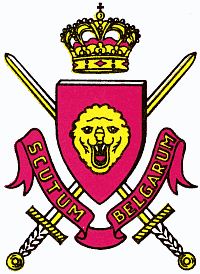 W
WThe Belgian Forces in Germany was the name of Belgium's army of occupation in West Germany after World War II. Lasting between 1946 and 2002, the army corps-strength FBA-BSD formed part of the NATO force guarding Western Europe against Warsaw Pact during the Cold War. At its height, 40,000 soldiers were serving with the unit with several thousand civilians also living in the Belgian zone around Cologne.
 W
WThe Berlin Air Safety Centre (BASC) was established by the Allied Control Council's Coordinating Committee on 12 December 1945. It was located in the former Kammergericht Building, on Kleistpark, Berlin. Operations began in February 1946 under quadripartite flight rules Paragraph 4. Paragraph 4 of the rules begins: "The Berlin Air Safety Centre has been established in the Allied Control Authority Building with the object of ensuring safety of flights for all aircraft in the Berlin area. BASC regulates all flying in the Berlin control zone and also in the corridors extending from Berlin to the boundaries of adjacent control zones."
 W
WThe Berlin Blockade was one of the first major international crises of the Cold War. During the multinational occupation of post–World War II Germany, the Soviet Union blocked the Western Allies' railway, road, and canal access to the sectors of Berlin under Western control. The Soviets offered to drop the blockade if the Western Allies withdrew the newly introduced Deutsche Mark from West Berlin.
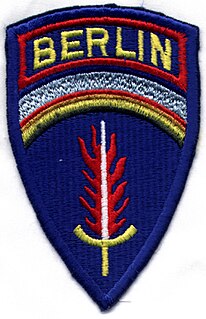 W
WThe Berlin Brigade was a US Army brigade-sized garrison based in West Berlin during the Cold War. After the end of World War II, under the conditions of the Yalta and Potsdam agreements, the Allied forces occupied West Berlin. This occupation lasted throughout the Cold War. The French Army also had units in Berlin, called Forces Françaises à Berlin and the British Army's unit in Berlin was the Berlin Infantry Brigade.
 W
WThe Berlin Infantry Brigade was a British Army brigade-sized garrison based in West Berlin during the Cold War. After the end of World War II, under the conditions of the Yalta and Potsdam agreements, the Allied forces occupied West Berlin. This occupation lasted throughout the Cold War. The French Army also had units in Berlin, called Forces Françaises à Berlin and the US Army's unit in Berlin was the Berlin Brigade.
 W
WThe Berlin Wall was a guarded concrete barrier that physically and ideologically divided Berlin from 1961 to 1989. Construction of the wall was commenced by the German Democratic Republic on 13 August 1961. The Wall cut off West Berlin from surrounding East Germany, including East Berlin. The barrier included guard towers placed along large concrete walls, accompanied by a wide area that contained anti-vehicle trenches, beds of nails and other defenses. The Eastern Bloc portrayed the Wall as protecting its population from fascist elements conspiring to prevent the "will of the people" from building a socialist state in East Germany.
 W
WThere were numerous deaths at the Berlin Wall, which stood as a barrier between West Berlin and East Berlin from 13 August 1961 until 9 November 1989. Before the construction of the Berlin Wall in 1961, 3.5 million East Germans circumvented Eastern Bloc emigration restrictions, many by crossing over the border from East Berlin into West Berlin. From there they could then travel to West Germany and other Western European countries. Between 1961 and 1989, the Wall prevented almost all such emigration.
 W
WThe Bizone or Bizonia was the combination of the American and the British occupation zones on 1 January 1947 during the occupation of Germany after World War II. With the addition of the French occupation zone on 1 August 1948 the entity became the Trizone. Later, on 23 May 1949, the Trizone became the Federal Republic of Germany, commonly known as West Germany.
 W
WThe Bonn–Paris conventions were signed in May 1952 and came into force after the 1955 ratification. The conventions put an end to the Allied occupation of West Germany.
 W
WThere have been two formations named British Army of the Rhine (BAOR). Both were originally occupation forces in Germany, one after the First World War, and the other after the Second World War. Both formations had areas of responsibility located around the German section of the River Rhine.
 W
WBritish Forces Germany (BFG) was the generic name for the three services of the British military, made up of service personnel, UK Civil Servants and dependents, based in Germany. It was established following the Second World War the largest parts of it becoming known as the British Army of the Rhine (BAOR) and RAF Germany (RAFG).
 W
WThe British Frontier Service was a British government organisation that was responsible for border monitoring duties in West Germany between 1946 and 1991. Its personnel served on Germany's international borders with Denmark, the Netherlands and Belgium before focusing on the inner German border. It was charged with a number of tasks, including assisting the movements of British military personnel and their dependents, monitoring the border regions and helping to defuse border incidents. It was ultimately disbanded following German reunification.
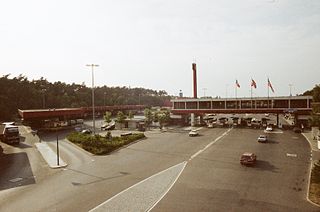 W
WCheckpoint Bravo was the name given by the Western Allies to the main Autobahn border crossing point between West Berlin and the German Democratic Republic. It was known in German as Grenzübergangsstelle Drewitz-Dreilinden. Drewitz is a community nearby, and Dreilinden is the name of the wooded area in Berlin through which the highway passes.
 W
WCheckpoint Charlie was the best-known Berlin Wall crossing point between East Berlin and West Berlin during the Cold War (1947–1991). Checkpoint "C" was short for "Checkpoint Charlie" as enshrined in NATO nomenclature and this is why it was subsequently christened Checkpoint Charlie.
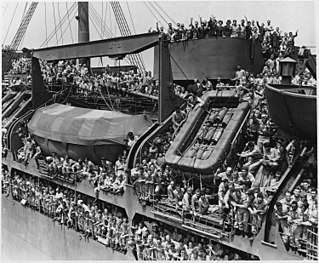 W
WThe Demobilization of United States armed forces after the Second World War began with the defeat of Germany in May 1945 and continued through 1946. The United States had more than 12 million men and women in the armed forces at the end of World War II, of whom 7.6 million were stationed abroad. The American public demanded a rapid demobilization and soldiers protested the slowness of the process. Military personnel were returned to the United States in Operation Magic Carpet. By June 30, 1947, the number of active duty soldiers, sailors, Marines, and airmen in the armed forces had been reduced to 1,566,000.
 W
WDenazification was an Allied initiative to rid German and Austrian society, culture, press, economy, judiciary, and politics of the Nazi ideology following the Second World War. It was carried out by removing those who had been Nazi Party or SS members from positions of power and influence and by disbanding or rendering impotent the organizations associated with Nazism. The program of denazification was launched after the end of the war and was solidified by the Potsdam Agreement in August 1945.
 W
WAmerican food policy in occupied Germany refers to the food supply policies enacted by the U.S., and to some extent its dependent Allies, in the western occupation zones of Germany in the first two years of the ten-year postwar occupation of Western Germany following World War II.
 W
WIn the years following World War II, large numbers of German civilians and captured soldiers were forced into labor by the Allied forces. The topic of using Germans as forced labor for reparations was first broached at the Tehran conference in 1943, where Soviet premier Joseph Stalin demanded 4,000,000 German workers.
 W
WForced labor of Germans in the Soviet Union was considered by the Soviet Union to be part of German war reparations for the damage inflicted by Nazi Germany on the Soviet Union during the Axis-Soviet campaigns (1941-1945) of World War II. Soviet authorities deported German civilians from Germany and Eastern Europe to the USSR after World War II as forced laborers, while ethnic Germans living in the USSR were deported during World War II and conscripted for forced labor. German prisoners of war were also used as a source of forced labor during and after the war by the Soviet Union and by the Western Allies.
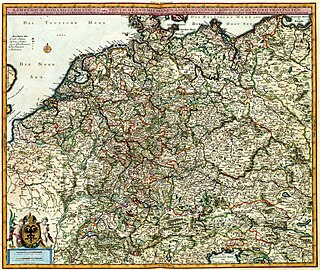 W
WThe term Four Ds refers to the four guiding principles of the allied occupation of Germany after World War II. Resulting from the Potsdam Conference in July to August 1945, they comprise: demilitarisation, denazification, decentralisation, and democratisation. Some historians add decartelisation or deindustrialisation to this list, creating the alternative name Five Ds.
 W
WThe Four Power Agreement on Berlin, also known as the Berlin Agreement or the Quadripartite Agreement on Berlin, was agreed on 3 September 1971 by the four wartime Allied powers, represented by their ambassadors. The four foreign ministers, Alec Douglas-Home of the United Kingdom, Andrei Gromyko of the Soviet Union, Maurice Schumann of France, and William P. Rogers of the United States signed the agreement and put it into force at a ceremony in Berlin on 3 June 1972. The agreement was not a treaty and required no formal ratification.
 W
WThe French Forces in Berlin were the units of the French Armed Forces stationed since 1945 until the end of the Cold War-era in West Berlin according to the agreements of the Yalta Conference and Potsdam Conference. The troops were the French counterparts to the United States' Berlin Brigade and the United Kingdom's Berlin Infantry Brigade in the city.
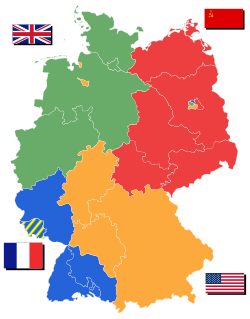 W
WFrench military forces were stationed in Germany after the surrender of Germany at the conclusion of the Second World War. France was one of four powers allocated an occupation zone. The French zone of occupation existed from the end of the war until 10 August 1949. Subsequently, the French military stationed forces in Germany with headquarters in Baden-Baden during the period of the Cold War.
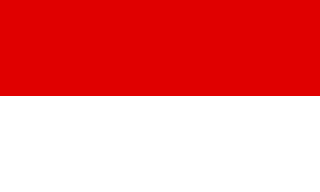 W
WGreater Hesse was the provisional name given for a section of German territory created by the US military administration in at the end of World War II. It was formed by the Allied Control Council on 19 September 1945 and became the modern German state of Hesse on 1 December 1946.
 W
WThe Western Group of Forces (WGF), previously known as the Group of Soviet Occupation Forces in Germany (GSOFG) and the Group of Soviet Forces in Germany (GSFG), were the troops of the Soviet Army in East Germany. The Group of Soviet Occupation Forces in Germany was formed after the end of World War II in Europe from units of the 1st and 2nd Belorussian Fronts. The group helped suppress the East German uprising of 1953. After the end of occupation functions in 1954 the group was renamed the Group of Soviet Forces in Germany. The group represented Soviet interests in East Germany during the Cold War. After changes in Soviet foreign policy during the late 1980s, the group shifted to a more defensive role and in 1988 became the Western Group of Forces. Russian forces remained in the eastern part of Germany after the dissolution of the Soviet Union and the German reunification until 1994.
 W
WThe State of Hanover was a short-lived state within the British Zone of Allied-occupied Germany. It existed for 92 days in the course of the dissolution of the Free State of Prussia after World War II until the foundation of Lower Saxony in 1946. The state saw itself in the tradition of the former Kingdom of Hanover, annexed by Prussia in 1866, reflected in the Saxon Steed state emblem. After Lower Saxony was founded by merging Hanover with several smaller states, it continued to use the Hanover emblems.
 W
WThe International Authority for the Ruhr (IAR) was an international body established in 1949 by the Western Allies to regulate the coal and steel industries of the Ruhr Area in West Germany. Its seat had been in Düsseldorf.
 W
WThe KGB Prison at Leistikowstraße 1 in the German city of Potsdam was a detention centre run by the Soviet counter-intelligence organisation, SMERSH.
 W
WThe Line of Contact marked the farthest advance of American, British, French, and Soviet armies into German controlled territory at the End of World War II in Europe. In general a "line of contact" refers to the demarcation between two or more given armies, whether they are allied or belligerent.
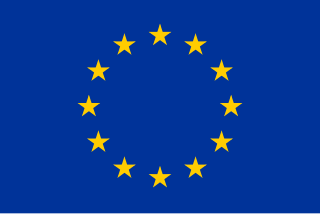 W
WThe London and Paris Conferences were two related conferences held in London and Paris during September–October 1954 to determine the status of West Germany. The talks concluded with the signing of the Paris Agreements, which granted West Germany full sovereignty, ended the occupation, and allowed its admittance to NATO. Furthermore, both West Germany and Italy joined the Brussels Treaty on 23 October 1954. The Agreements went into force on 5 May 1955. The participating powers included France, the United Kingdom, Belgium, the Netherlands, Luxembourg, West Germany, Italy, Canada, the United States, and remaining NATO members.
 W
WNeulehrer (literally "new teachers" is the name given to the educational personnel graduating from a course that isn't integrated in a degree, introduced by the Allies in the four occupation zones of Germany from 1945 to 1949. The allied goal was to substitute all teachers influenced by a Nazi past in German schools and guarantee that the German youth would receive a pro-democracy education.
 W
WThe Province of North Rhine, also called North Rhine Province, was a short-lived administrative region in the British occupation zone of Germany, which was formed from the northern part of the Rhine Province after the end of the Second World War.
 W
WThe Occupation Statute of Germany of April 10, 1949 specified the roles and responsibilities of the newly created government of the Federal Republic of Germany and the Allied High Commission. It was drawn up by American, British, and French representatives and was in force until the Treaties of Paris (1954) came into force on May 5, 1955.
 W
WThe Office of Military Government, United States was the United States military-established government created shortly after the end of hostilities in occupied Germany in World War II. Under General Lucius D. Clay, it administered the area of Germany and sector of Berlin controlled by the United States Army. The Allied Control Council comprised military authorities from the United States, the United Kingdom, the Soviet Union and France. Though created on January 1, 1946, OMGUS previously reported to the U.S. Group Control Council, Germany (USGCC), which existed from May 8, 1945 until October 1, 1945. OMGUS was eliminated on December 5, 1949, and the U.S. High Commissioner for Germany assumed control of its functions.
 W
WOperation Paperclip was a secret United States intelligence program in which more than 1,600 German scientists, engineers, and technicians were taken from former Nazi Germany to the U.S. for government employment after the end of World War II in Europe, between 1945 and 1959. Conducted by the Joint Intelligence Objectives Agency (JIOA), it was largely carried out by special agents of the U.S. Army's Counterintelligence Corps (CIC). Many of these personnel were former members, and some were former leaders, of the Nazi Party.
 W
WThe Petersberg Agreement is an international treaty that extended the rights of the government of West Germany vis-a-vis the occupying forces of the United Kingdom, France, and the United States. It is viewed as the first major step of West Germany towards sovereignty. It was signed by West German Chancellor Konrad Adenauer and Allied High Commissioners Brian Hubert Robertson, André François-Poncet (France), and John J. McCloy on 22 November 1949. The Hotel Petersberg, near Bonn, was the seat of the High Commissioners and the place of signature. The agreement was the first modification of the Occupation Statute.
 W
WPost–World War II demobilization strikes occurred within Allied military forces stationed across the Middle East, India and South-East Asia in the months and years following World War II. American military personnel based in occupied Germany were holding mass parades for speedier demobilization and in the Philippines formed soldiers committees and went on demonstrations calling for a return home. In India, thousands of Royal Air Force servicemen pushed for demobilization and went on strike citing grievances over conditions of work such as deaths in high temperatures in Cawnpore and overcrowding at RAF Jodhpur. A "Forces Parliament" was set up - effectively a workers' council, but was dissolved before the issues came to a head. The issue was a major subject of debate in the British Parliament. At one point Prime Minister Clement Attlee was presented with a petition by India-stationed servicemen that stated:
 W
WThe Potsdam Agreement was the 1 August 1945 agreement between three of the Allies of World War II: the United Kingdom, the United States, and the Soviet Union. A product of the Potsdam Conference, it concerned the military occupation and reconstruction of Germany, its borders, and the entire European Theatre of War territory. It also addressed Germany's demilitarisation, reparations, the prosecution of war criminals and the mass expulsion of ethnic Germans from various parts of Europe.
 W
WThe President's Economic Mission to Germany and Austria was a series of reports commissioned by US President Harry S. Truman and written by former US President Herbert Hoover.
 W
WAs Allied troops entered and occupied German territory during the later stages of World War II, mass rapes of women took place both in connection with combat operations and during the subsequent occupation of Germany. Scholars agree that the majority of the rapes were committed by Soviet occupation troops. The wartime rapes were followed by decades of silence. According to historian Antony Beevor, whose books were banned in 2015 from some Russian schools and colleges, NKVD files have revealed that the leadership knew what was happening, but did little to stop it. It was often rear echelon units who committed the rapes. According to professor Oleg Rzheshevsky, "4,148 Red Army officers and many privates were punished for committing atrocities". The exact number of German women and girls raped by Soviet troops during the war and occupation is uncertain, but historians estimate their numbers are likely in the hundreds of thousands, and possibly as many as two million.
 W
WRIAS was a radio and television station in the American Sector of Berlin during the Cold War. It was founded by the US occupational authorities after World War II in 1946 to provide the German population in and around Berlin with news and political reporting.
 W
WThe Soviet Occupation Zone was an area of Germany occupied by the Soviet Union as a communist area and it was established as a result of the Potsdam Agreement on 1 August 1945. On 7 October 1949 the German Democratic Republic (GDR), commonly referred to in English as East Germany, was established in the Soviet Occupation Zone.
 W
WSpandau Prison was located in the borough of Spandau in western Berlin. It was originally a military prison, but became a proto-concentration camp under the Nazis. After the war, it held seven top Nazi leaders convicted in the Nuremberg trials. It was constructed in 1876 and demolished in August 1987 to prevent it from becoming a neo-Nazi shrine after the death of its last prisoner, Rudolf Hess, who had died from a suspected suicide aged 93. The site was later rebuilt as a shopping centre for the British forces stationed in Germany.
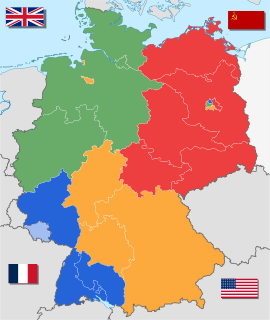 W
WThe Stalin Note, also known as the March Note, was a document delivered to the representatives of the Western Allies from the Soviet Union in Germany on 10 March 1952. Soviet Premier Joseph Stalin put forth a proposal for a German reunification and neutralisation with no conditions on economic policies and with guarantees for "the rights of man and basic freedoms, including freedom of speech, press, religious persuasion, political conviction, and assembly" and free activity of democratic parties and organizations.
 W
W"Mr. Gorbachev, tear down this wall", also known as the Berlin Wall Speech, was a speech delivered by United States President Ronald Reagan in West Berlin on June 12, 1987. Reagan called for the General Secretary of the Communist Party of the Soviet Union, Mikhail Gorbachev, to open the Berlin Wall, which had separated West and East Berlin since 1961. The name is derived from a key line in the middle of the speech: "Mr. Gorbachev, tear down this wall!"
 W
WThe Tränenpalast is a former border crossing point between East and West Berlin, at Berlin Friedrichstraße station, which was in operation between 1962 and 1989. It is now a museum with exhibitions about Berlin during the Cold War period and about the process of German reunification. It was the border crossing for travellers on the S-bahn, U-bahn and trains going between East and West Germany. It was used only for westbound border crossings. It had separate checkpoints for West Berliners, West Germans, foreigners, diplomats, transit travellers and East Germans.
 W
WThe Treaty on the Final Settlement with Respect to Germany, or the Two Plus Four Agreement, was negotiated in 1990 between the Federal Republic of Germany and the German Democratic Republic, and the Four Powers which occupied Germany at the end of World War II in Europe: France, the Soviet Union, the United Kingdom, and the United States. In the treaty, the Four Powers renounced all rights they held in Germany, allowing a reunited Germany to become fully sovereign the following year. At the same time, the two German states agreed to confirm their acceptance of the existing border with Poland, and accepted that the borders of Germany after unification would correspond only to the territories then administered by West and East Germany, with the exclusion and renunciation of any other territorial claims.
 W
WThe United States Constabulary was a United States Army military gendarmerie force. From 1946 to 1952, in the aftermath of World War II, it acted as an occupation and security force in the U.S. Occupation Zone of West Germany and Austria.
 W
WWolf children or Little Germans were German street children that existed in East Prussia at the end of World War II. Wolf children were mostly orphans left behind in the Evacuation of East Prussia and Red Army invasion in early 1945, with many living homeless in the forests of East Prussia or adopted by Lithuanian families.